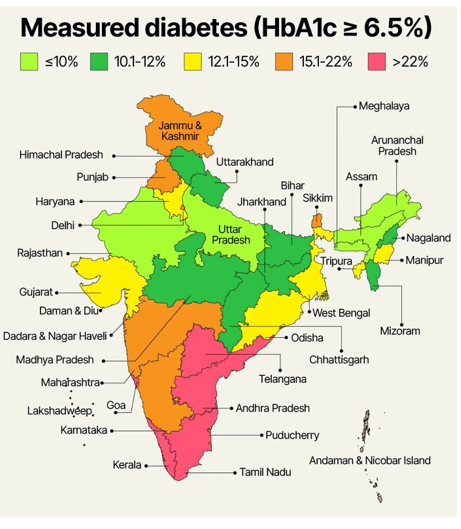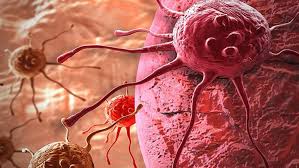SYLLABUS
GS-1: Issues relating to development and management of Social Sector/Services relating to Health.
Context:
Recently, a study published in the Lancet Global Health journal reveals that at least 1 in 5 people aged 45 and older in India had diabetes in 2019.
About Longitudinal Aging Study
The study, published in The Lancet Global Health, is based on data from the Longitudinal Aging Study in India (LASI), which surveyed nearly 60,000 adults aged 45+ between 2017–2019 to estimate the prevalence, awareness, treatment and control of diabetes.
- The Longitudinal Aging Study in India (LASI) is a comprehensive, nationwide panel study investigating the health, economic, and social well-being of India’s older adult population (aged 45 and above) and their spouses.
LASI is nationally and state-level representative, covering health conditions like BMI, hypertension, and diabetes.
Blood samples were tested for HbA1c (an integrated measure of diabetes over the previous 90 days) levels in a lab (ICMR-NITVAR, Pune), a more accurate method than random glucose testing.
Key Findings of the Study
Prevalence: In 2019, one in five Indians aged 45 years and above had diabetes, with prevalence rates of 19.6 percent in men and 20.1 percent in women.
The condition affected around 30 percent of the urban population, which was twice the rural rate of 15 percent.

Awareness: About 60 percent of people with diabetes are aware of their condition. Among the elderly aged 60 years and above, 8 percent have undiagnosed diabetes that is an estimated 20 million Indians were living with undiagnosed diabetes.
Treatment & Control: Among those aware of their condition, 94 percent received treatment, yet only 36 percent are adequately treated, while 5 percent remain untreated and 47 percent are under-treatment.
- In terms of health control, 46 percent have regained blood sugar control and 59 percent have achieved blood pressure control. However, only 6 percent use lipid-lowering medication
State-Level Trends
Highest age-adjusted prevalence (45+):
- Chandigarh – 36.9%
- Kerala – 36.0%
- Puducherry – 36.0%
Maximum number of cases:
- Tamil Nadu – 6.1 million
- Maharashtra – 5.8 million
- Uttar Pradesh – 4.7 million
Geographic Distribution: Southern states generally have higher rates; central and northeastern states have lower rates.
Diabetes
Diabetes is a chronic, metabolic disease characterized by elevated levels of blood glucose (blood sugar), which over time leads to serious damage to the heart, blood vessels, eyes, kidneys, and nerves.
It occurs either when the pancreas does not produce enough insulin or when the body cannot effectively use the insulin it produces.
- Glucose (sugar) mainly comes from carbohydrates in your food and drinks.
Types of Diabetes: There are several types of diabetes. The most common forms include:
Type 1 Diabetes
- Previously, it was known as insulin-dependent, juvenile, or childhood-onset diabetes.
- It is characterised by deficient insulin production and requires daily administration of insulin.
- Neither its cause nor the means to prevent it are known.
Type 2 Diabetes
- It is formerly known as non-insulin-dependent or adult-onset diabetes, but now increasingly seen in children, affects how the body uses sugar for energy and prevents proper use of insulin, leading to high blood sugar if untreated.
- It can cause serious long-term damage to nerves and blood vessels, but is often preventable through healthy weight management, regular exercise, and awareness of genetic risks, making early diagnosis through check-ups and blood tests crucial.
- Its symptoms are often mild and slow to appear, and over 95% of people with diabetes have this type.
Gestational Diabetes
- Hyperglycaemia with blood glucose values above normal but below those diagnostic of diabetes.
- It is a type of diabetes that develops during pregnancy. In most of the cases, this type of diabetes goes away after the baby is born.
Key Symptoms of Diabetes
- Symptoms can occur suddenly (especially in type 1 diabetes). In type 2 diabetes, the symptoms may be mild and take years to be noticed.
Common symptoms include:
- Feeling very thirsty.
- Needing to urinate more often than usual.
- Blurred vision.
- Feeling tired.
- Losing weight unintentionally.


